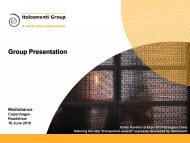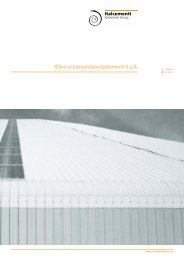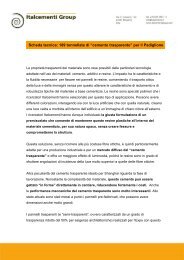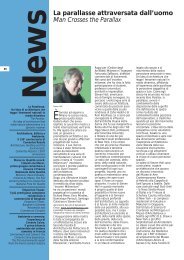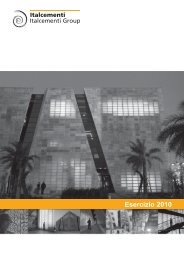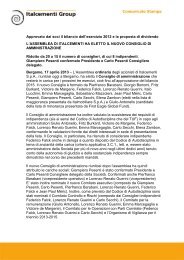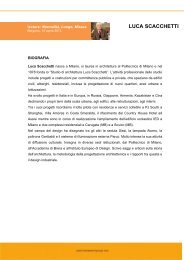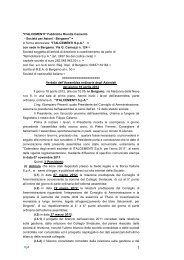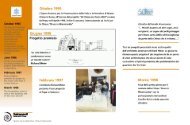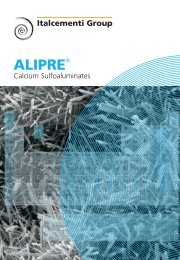88-96**news ital-ingl 2¡ bozza - Italcementi Group
88-96**news ital-ingl 2¡ bozza - Italcementi Group
88-96**news ital-ingl 2¡ bozza - Italcementi Group
You also want an ePaper? Increase the reach of your titles
YUMPU automatically turns print PDFs into web optimized ePapers that Google loves.
ArcVision decided to publish the letter written by the Oslo Permanent Committee for Urban<br />
Development to the municipality of Bilbao as a tribute to the commitment of Financiera y Minera,<br />
the Spanish subsidiary of the <strong>Italcementi</strong> <strong>Group</strong>, in the program of the Basque City’s urban redevelopment.<br />
Financiera y Minera (Cementos Rezola and Hormigones y Minas) has been actively involved in the<br />
successful “rev<strong>ital</strong>ization” of the city of Bilbao. It has played and active role in the completion of the city’s<br />
most significant works over the past five years, the most notable being the Guggenheim Museum, the<br />
Metropolitan, the new “Euskalduna” Conference Center, the new “Santiago Calatrava” airport terminal,<br />
the infrastructures surrounding the city, the “Calatrava” bridge above Bilbao’s river, etc…<br />
In 2001, Financiera y Minera also played an especially active role in the city’s 700th anniversary celebrations<br />
by sponsoring several important urban development operations which placed artistic/architectural elements<br />
in the main squares and crossroads of the city for six months.<br />
All these operations have strengthened Financiera y Minera’s position as a leading actor in the urban<br />
development and rev<strong>ital</strong>ization of the Bilbao metropolitan area.<br />
A representation from Oslo<br />
Town Hall, the Permanent<br />
Committee for Urban<br />
Development, visited Bilbao in<br />
September 2001, following a<br />
seminar in Oslo in February<br />
called “Bilbao, the will to<br />
succeed!”. The seminar<br />
helped us to clarify the various<br />
aspects of successful<br />
rev<strong>ital</strong>ization of the city –<br />
created, among other factors,<br />
by efficient and wellorganized<br />
co-operation<br />
between the public and<br />
private sectors. In any case,<br />
the most important point is<br />
that Bilbao was providing<br />
evidence of a completely new<br />
tendency in town planning.<br />
Thus we lost no time in<br />
arranging a visit to the cap<strong>ital</strong><br />
of Vizcaya in order to examine<br />
in situ the process which had<br />
aroused such interest in our<br />
country.<br />
During the visit, we quickly<br />
realized that one of the<br />
conditioning factors which<br />
had produced such<br />
developments was<br />
organization of planning and<br />
execution in a nonbureaucratic<br />
and flexible<br />
manner. A further aspect, we<br />
realized, was that the original<br />
idea was not solely based on<br />
local concerns, but had been<br />
extended to include the<br />
region around Bilbao and the<br />
country as a whole. Thirdly,<br />
we felt that markets and<br />
industry within the province<br />
have maintained a positive<br />
attitude with regard to cooperation<br />
and execution of<br />
the various projects. Last but<br />
not least, we reached the<br />
conclusion that Bilbao had<br />
little or no choice in the<br />
matter. The city had to do<br />
something, after all!<br />
If we transfer all these<br />
concerns to Oslo, we would<br />
be faced with an enormous<br />
challenge – establishing an<br />
organizational structure as<br />
powerful as in Bilbao. Our<br />
parliamentary system contains<br />
no precedents for setting up<br />
an organization with a wide<br />
range of authority which can<br />
spearhead the process of<br />
urban development. The Town<br />
Hall is the highest authority<br />
with regard to both town<br />
planning and problems<br />
relating to property and<br />
finance, but it has no<br />
experience in the creation of<br />
the co-ordination which<br />
would be required on such a<br />
large scale.<br />
Within this context, Oslo faces<br />
one of the most extensive<br />
development tasks in many<br />
decades – namely,<br />
transforming our local port<br />
area, Bjørvika, and turning it<br />
into a multi-functional city<br />
area for housing, trading, and<br />
cultural and leisure activities.<br />
This area represents the city’s<br />
best bet, and so a<br />
development company has<br />
been created to this end, with<br />
the Town Hall as a<br />
shareholder.<br />
At the moment, we have no<br />
idea as to how our project will<br />
develop, since we are still very<br />
much in the early stages, but<br />
one thing we are certain<br />
about is that we like Bilbao,<br />
and we like the way things<br />
are being done. We have<br />
visited many parts of the Villa<br />
(as you call your city), we have<br />
been to the Guggenheim<br />
Museum and have admired<br />
the bright colors of the street<br />
cows in commemoration of<br />
the 700th anniversary of the<br />
city. This was a real pleasure<br />
for us. It was then that we<br />
remembered our tiger, the<br />
symbol of Oslo on the city’s<br />
commemoration in 2000 of its<br />
1,000 years of existence. But<br />
that is another story, and we<br />
will tell you about it when you<br />
come here. In any case, Bilbao<br />
is a city we would love to<br />
come back to!<br />
Kari Kiil<br />
Secretary of the Permanent<br />
Committee for<br />
Town Planning in Oslo<br />
Text and images provided<br />
to arcVision by the magazine<br />
Bilbao Ría 2000)<br />
93<br />
Un’immagine<br />
notturna del Museo<br />
Guggenheim.<br />
A night view of<br />
the Guggenheim<br />
Museum.



